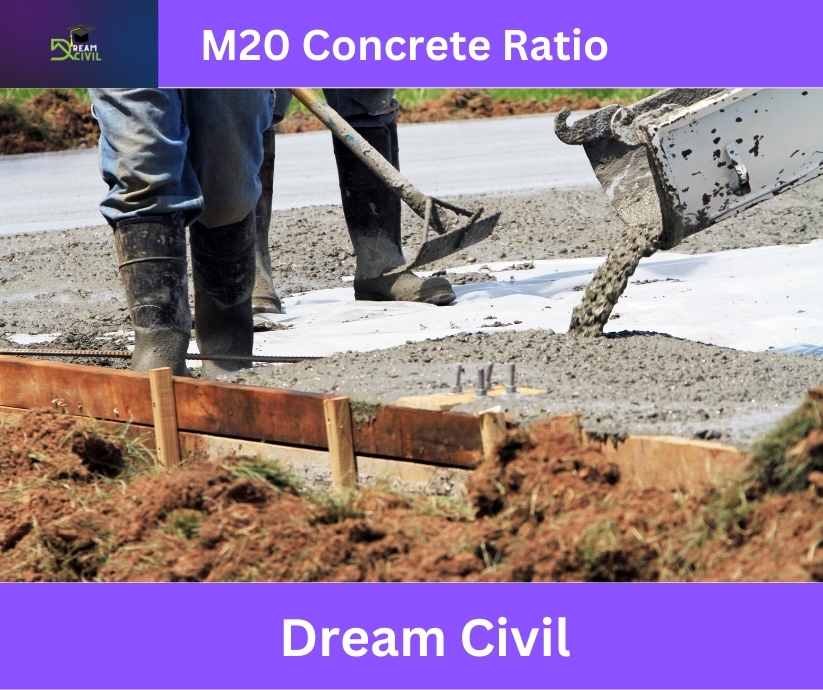Table of Contents
M20 concrete ratio is 1:1.5:3. It indicates the cement:sand: aggregate ratio. It simply means that if 1 kg cement is used for making Concrete, you should use 1.5 kg sand and 3 kg aggregate. ( i.e. 1 part cement: 1.5 parts sand: 3 parts aggregate )
✔ In M20 concrete,

“M” stands for Mix ratio of cement:sand: aggregate & “20 “Stands for Compressive Strength @ 28 Days in N/mm².
✔ M20 Concrete is nominal Concrete that can be skillfully prepared using Indian Standard IS 456:2000.
✔ Normally, about 38% of water is required for the complete hydration of Concrete.
As per Indian Standard IS 456:2000 for nominal mix ( i.e., M10, M15…, M25), the w/c ratio varies from 0.4 to 0.6.
For M20 Concrete, commonly w/c ratio of 0.45 to 0.50 is used.
1. Table1: M20 Concrete Ratio – Overview
| Code | Indian Standard 10262(2009). |
| Ratio | 1:1.5:3 |
| Compressive Strength | 20 MPa { Note: MPa = N/mm²} |
| Uses | Used in RCC works like; a. Rigid Pavement Construction b. Used to construct structural members like slabs, beams, columns, etc. (for small to medium structures only. Not suitable for heavy structures or work). c. Water retaining structures, piles, etc. |
| Grade Category | Normal Grade ( Nominal Mix ) |
| Required Water Cement Ratio | a. For high-quality concrete works; 0.45 w/c ratio is specified. b. Minimum water-cement ratio: 0.45 c. Maximum water-cement ratio: 0.50
|
2. M20 Concrete Ratio Uses
This concrete grade is commonly used for small to medium-scale constructions. Some common uses of the M20 Concrete Ratio are:

✔ Used in the construction of water retaining structures.
✔ Used to construct piles and other general RCC structures.
✔ Used to build retaining walls, buildings, landscaping & architectural designs, etc.
3. Cement Sand Aggregate Calculation For 1 m³ M20 Concrete Ratio
Data per 1 m³ of M20 Concrete Ratio
| Material | Volume Required (m3) | Materials Required in kg |
| Cement | 0.28 | 403.2 |
| Fine Aggregate | 0.42 | 619.85 |
| Coarse Aggregate | 0.84 | 1359.82 |
| Water | 0.190 | 190 kg ( Average ) |
| Things To Know!! Density of Cement = 1440 kg/m3 Density of Sand = 1450-1500 Kg/m3 Density of Aggregate = 1450-1550 Kg/m3 Weight of Cement in 1 Bag = 50 Kg Volume of 1 Bag of Cement in Cubic meter = 0.03472 m3 |
Now, Taking
Grade of Concrete = M20 Concrete
Mix Ratio = 1:1.5:3
Total sum of ratio =1+1.5+3 =5.5
Wet volume of Concrete = 1 m3.
To get dry volume, wet volume increased by 54%
Dry volume of concrete = 1 + 0.54 = 1.54 m³
i. Cement Quantity Calculation
Quantity of cement = (Own Ratio/ Total sum of ratio) * Dry Volume
= ( 1/5.5 ) * 1.54
= 0.28 m³
Cement in kg = volume of cement * density of cement
= 0.28 * 1440
= 403.2 kg
ii. Sand Quantity Calculation
Quantity of sand = (Own Ratio/ Total sum of ratio) * Dry Volume
= ( 1.5/5.5 ) * 1.54
= 0.42 m³
iii. Aggregate Quantity Calculation
Quantity of aggregate = (Own Ratio/ Total sum of ratio) * Dry Volume
= ( 3/5.5 ) * 1.54
= 0.84 m³
iv. Water Calculation
For inferior-quality concrete: W/C ratio = 0.5
For superior-quality concrete: W/C ratio = 0.45
Minimum amount of water required per m³ = 0.45 * 403.2 = 181.44 kg
Maximum amount of water required per m³ = 0.5 * 403.2 = 201.6 kg
4. References |
| Read Also: Grades of Concrete |
| Verified Article By Er. Madhu Krishna Poudel |

